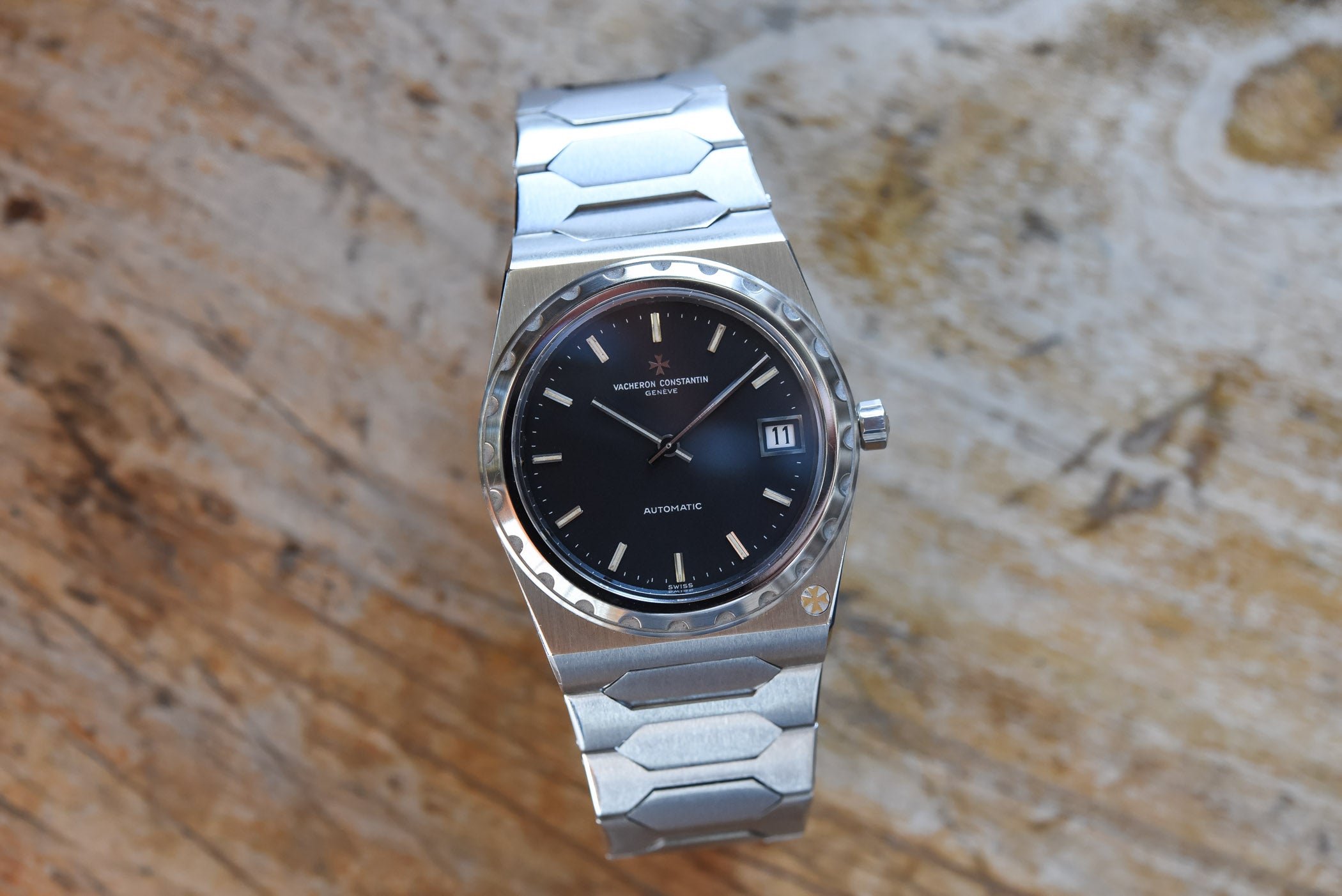The Story of the Vacheron Constantin 222
It's a given that the monetary value of any collectable object is based on quality, rarity, provenance, originality and condition. But there's a sixth major driver, too – and that's hype.
Hype can be slow to build, but it is all but unstoppable once a head of steam has been reached. Hype has been the driving force behind the soaring values of classic cars such as the Ferrari 250GTO and the Lamborghini Miura, the motorcycles built by Vincent and Brough Superior, the prints and paintings of Andy Warhol and Jean-Michel Basquiat, the handbags of Hermès and Chanel and the furniture of Charles Eames and Gio Ponti.

There might not be hype but the other five factors of collectability are certainly there.
There are numerous alternatives in the fields of all of the above that are just as good, just as functional, just as well executed and just as attractive, maybe even all-round better - but if they haven't been boosted by 'hype', collectors often aren't interested. Or, if they are, they're too put-off by the often-undeserved B-list reputation of such objects to risk paying really good money to own them.
The effect of hype has certainly done its stuff in the world of collectable watches, hence the fame and desirability of models such as the Heuer Monaco, the Omega Speedmaster, the Rolex Cosmograph. Oh, and the Audemars Piguet Royal Oak and the Patek Philippe Nautilus. In the context of this article, the latter two are the ones that matter – because they represent the two successful elements of what, logically speaking, should be a familiar triumvirate. But isn't, because the third member has never been properly hyped.


These two probably come to mind when integrated sports watches are mentioned.
Every horophile in the land has heard ad nauseam about the late, great Gérald Genta penning the Royal Oak in a single, overnight sketching session, before the 1971 Basel watch fair, employing his recently conceived integrated bracelet approach to create what, decades later, was judged an all-time classic – even though it apparently took Audemars Piguet a while to shift the first 1,000 examples.
Likewise, Genta's other celebrated design, the Nautilus of 1976, enabled the usually reserved Patek to make headway in the growing sector of funky steel sports watches. First-series steel versions of the Nautilus and 'A' series Royal Oaks in good condition have now soared in price. An original cork Nautilus box alone recently fetched £9,375 at a Sotheby's online auction. The ultra-rare white gold Nautiluses – admittedly different beasts from their steel counterparts – are even making half-a-million plus.
So what of the triumvirate's third member, the one that has been largely excluded from the magic circle?


The under-appreciated challenger from Vacheron Constantin.
We speak, of course, of Vacheron Constantin's equally notable and certainly as covetable '222', the integrated sports watch launched in 1977 to mark the 222nd anniversary of the venerable brand's founding.
When enthusiasts write and chat about the wonders of the Nautilus and the Royal Oak, invariably citing the nautical inspirations behind them – undersea mollusc and diving helmet – they often mention the 222 in passing, sometimes referring to it as another Genta design.
That myth is now dying out, as more people discover that the 222 was not just the work of the young Jörg Hysek, a watch design giant of equally impressive stature as Genta, but a rather brilliant piece of work, too.

A slightly older Jörg Hysek being interviewed by The Naked Watchmaker.
Born in East Berlin in May 1953, Hysek and his family moved to Geneva when he was seven – shortly before the building of the Berlin wall. He studied micromechanics for two years at the Bienne technical Institute, and then enrolled at the Vocational School for Watchmakers in Pforzheim. However, he subsequently headed to art college, first in Germany and afterwards at London's prestigious Royal Academy of Art.
Back in Switzerland, he was soon snapped-up by Rolex, where he worked as a designer for four years before quitting to establish his own business, Hysek Styling – and one of his first clients was Vacheron Constantin, which was on the hunt for an unusual watch with which to mark its equally unusual anniversary. Then, like now, it was the oldest watch house to have remained in continuous production.

Hysek’s design, over 40 years on, courtesy of Monochrome.
But this wasn't to be Vacheron's first attempt at what would be termed a 'sports elegance' bracelet watch. Back in 1975, the house had created the Reference 2215 Chronometer Royal, an odd-looking rectangular watch with scalloped corners to the case and a soft-edged, octagonal bezel. It could almost be regarded as a pastiche of Nautilus and Royal Oak signatures, although it bore more of a resemblance to the former.
An abject failure in period, although somehow quite appealing today, the 2215 ceased production in 1977. It prompted Vacheron's urgent need to replace it with something more commercial – just as Hysek was starting out on his career as a pen for hire. "It is a popular misconception that Genta designed the 222, simply because his other integrated bracelet models have become so well known," explains Christian Selmoni, Vacheron Constantin's style and heritage director.

How the original 222 customers would have received their watch.
"In reality, Jörg Hysek just walked in with his drawings and sold them to us. The watches were then developed in-house, with outside specialists being commissioned to make various components."
So, not much of a story, really – and hence, no hype.
However, taken on the basis of style and substance, there is absolutely no reason why the 222 should not be as desirable, as collectable and therefore as valuable as its better known counterparts – if not more so.
Technically, it matches them by dint of its Calibre 1120 movement – the reference Vacheron applied after tweaking the very same, ultra-thin Jaeger-LeCoultre 920 mechanism that was used in both the Nautilus and the Royal Oak. Were the three watches being made in the same way today, the 222 might even have the edge over its rivals as it could claim 'manufacture' status by virtue of the fact that Vacheron and JLC were still one following their 1938 merger.

A 222 originally bought in 1986 with its guarantee card, courtesy of Hodinkee Shop.
Then, there's the case shape – a tonneau base with that very distinctive, notched bezel that makes the watch as interesting as the Royal Oak and Nautilus, without being so unusual as to put buyers off. Let's remember, after all, that this was in an era when mechanical watchmaking was on the wane and the traditional customer was nothing short of the life blood of a such an ancient maison.
The dials, of course, were top quality. Available in a choice of blue grey or charcoal grey - echoes of the Nautilus again - they were made, Selmoni believes, by Geneva-based Stern Créations. Meanwhile, the key to the whole thing, the integrated bracelet, was another local product from the best in the business: Gay Frères of 12, Glacis-de-Rive, the metalwork specialist that grew from its 19th century roots as a maker of pocket watch chains to become the most respected bracelet manufacturer in the world - so much so that it was bought by Rolex in 1998.

An original photoshoot with the 222.
Launched at the Basel fair in 1977, the 222 was sold in a set with a money clip that matched the design of the notched bezel which, along with the gold Maltese cross set into the bottom right corner of the brushed metal case, must have made the watch a real, stand-out piece.
Once production was underway, the 222 could be had in the two-hand 'jumbo' size of 37mm, with a 34mm 'mid-size' case and three hands or as a 24mm, quartz-powered woman's model. The availability of steel, yellow gold, white gold and two-tone finishes across all models also broadened the range, and there were also a few in white gold with diamond set bezels or diamonds set into the bracelet links.


The small details that bring this reference to life.
It is commonly stated that just 500 examples of the 222 were produced during its eight-year production life but, according to factory records, there were more than 1,300 ladies versions, around 1,000 mid-size models and approximately 700 'jumbos', with the rarest of the rare being the latter in white gold. There were also a few examples with silver or, even scarcer, white dials.
Compared with the 3,300 examples of the reference 3700/1 Nautilus produced - across both narrow and wide bracelet types - the 222 is considerably less common, even when mid-size and jumbo production is combined. It’s this sudden discovery of that winning combination of rarity and quality which is why, Selmoni believes, collectors are now avidly seeking 222s.
"For years, we heard hardly anything about the 222," he told A Collected Man, "but now more and more people are getting in touch about them. There is a huge amount of interest for steel sports elegance watches from the 1970s and there has been an extra spotlight shone on the 222 recently by the success of the current Overseas model which is directly descended from it."

Is this now in the same conversation as the Nautilus and Royal Oak?
The thing that has really surprised Selmoni about the 222, however, is that it wasn't just a cushion-cased watch with a round dial – but a square-cased watch, too.
"In researching the 222, I was amazed to discover that there was this second version that was nothing to do with Jörg Hysek, but was entirely the idea of the management. It had a square case with flat corners, a square dial and, again, a fully integrated bracelet."
But that, as they say, is a whole other story...



























































































































































































